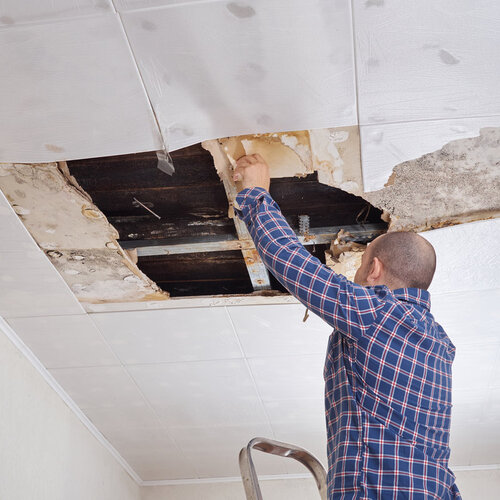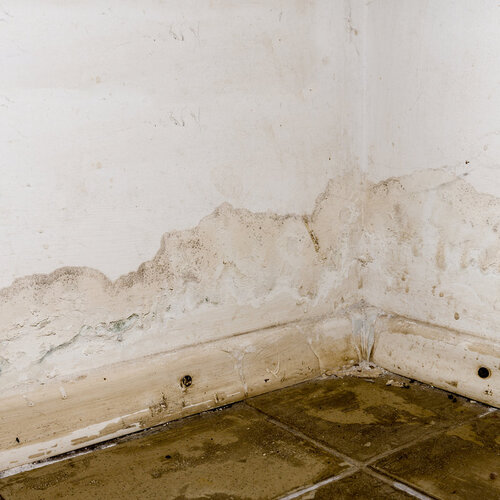
The Damage That Water Can Do
Water is a necessity, yet it is also evil for structures. How can something so good and healthy for humans be so bad for your home? The evil we’re talking about is the water damage, and the need for water damage repairs a simple leak can cause. And sometimes, you don’t even know you have water damage until the damage is severe.
What does water damage look like?
No matter whether the water damage is from a leaking pipe or a flood, it causes structural problems. If water damage repairs aren’t done quickly, it can lead to mold, creating a health risk for everyone in the home.
The following steps will help you identify water damage inside and outside the home. The sooner you can get water damage repairs done, the better.
The Exterior
- A house should be built at the highest position with the ground sloping away. When the house is on level ground on the ground slopes toward the house, it puts the foundation in a vulnerable position for water damage. Repairs on a foundation must be done promptly and correctly to keep the integrity of the foundation and house.
- Walking around the exterior, check that the downspouts are installed so the water is diverted away from the house. Make sure the gutters are in good condition and attached securely to the house. Any leak in the gutters or down spout can damage the fascia and siding, as well as other damage, requiring extensive water repair damage.
- Observe if there are cracked or missing flashing or roofing shingles. This can leave the roof vulnerable to attic leaking that develops into more damage. The damage may appear to be cosmetic, but a professional inspection should be done to determine if any water damage repairs are needed.
- Check the exterior door and window frames for separation or soft spots. These gaps and separation can lead to humidity issues in the house, harvesting mildew and mold. Proper precautions such as water damage repairs around the doors and windows as soon as they’re needed will save you from more extensive damage later.
The Interior
- Check for any water rings and stains on the ceiling or walls. These could be plumbing leaks or a roof leak. Make extra effort to look for smaller water stains where there is plumbing. If you find any, listen for water leaks inside the walls during the night when all is quiet.
- Sagging or soft areas of the floor can indicate leaks around bathtubs, showers, and sinks. Check around the dishwasher, refrigerator, washing machine, and water heater. These can be small leaks that have gone for some time creating severe water damage. Repairs should be quick within the flooring and walls around these appliances.
- Check the flooring for any cracks or warping, no matter if it is laminate, tile, or wood. Water damage repairs to any type of flooring is expensive.
- Check under sink cabinets for discolored cabinet floors or walls, warping, and dampness. If there is dampness, there is mildew and mold too and you should contact a professional immediately. From water damage repairs to mold remediation, this can become a serious issue quickly.
- Examine the water heater for rust on the tank, behind the tank, on the water connections and PRV. Rust in these areas can be from a previous leak or there may be a current that needs water damage repair.
- The nose knows – if you smell mildew or must, you have a water leak somewhere. Hire a professional if you can’t find the water leak. Repairs should be made immediately.
How long before water damage causes mold?
Water exposure can cause mildew and mold within 24 to 48 hours. Once it develops, it keeps growing and spreading until the source of the leak is fixed and water damage repairs are completed. Never assume that because you cleaned the mildew and mold up that the cause of it is gone too.
Is there always mold with water damage?
No matter what time of year it is, summer or winter, if the water isn’t dried within 24 hours, mildew will begin. If more than minor water damage happens, the mold will start soon after the mildew.
Who do you call to fix water damage?
If the water damage repair is due to a busted water pipe, you’ll need to call a plumber first to fix the plumbing leak. Once the plumbing is fixed, then you need to call a contractor that knows how to repair water-damaged wood, like a handyman or carpenter. If the water damage repair is needed because of a leaking roof, you’ll need to call a roofing contractor.
You should interview a couple of different contractors and ask what their process is, including how to repair a water-damaged ceiling and how to repair water-damaged drywall. You want to make sure they are going to remove any damaged wood and replace it. Leaving any water-damaged wood behind could keep mildew and mold coming back even if the plumbing issue has been fixed.
How much does water damage repair cost?
It will depend on the amount of water damage repair needed and what is damaged. If the water damage is contained under one sink, the repair could cost $150 to $200 for labor and material. If an entire wall, or a ceiling has water damage, repairs could reach $6,000 to $8,000.

Finishing Up With a Common Question
So – what water damage is covered by insurance? Most standard homeowner insurance policies will cover water damage repairs for accidental or sudden occurrences. However, water damage repairs because of homeowner neglect, like an aging roof or water heater that should have been replaced, your claim will be declined.

